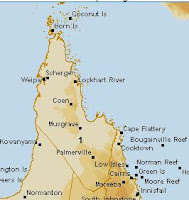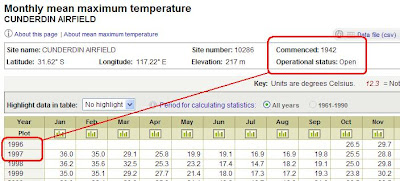Since 1960 the mean temperature in Australia has increased by about 0.7°C.The key is in the words "mean temperature", which is also used in the caption accompanying the Figure on page 1 ("Trend in mean temperature 1960-2009 (ºC/decade)"). To understand the precise significance of this term "mean temperature" requires a bit of digging.
Firstly, a bit of history. The BoM maintains a network of weather observation station across Australia. These stations (and their data) can be accessed from the following web page:
http://www.bom.gov.au/weather/index.shtml
The BoM also maintains a Reference Climate Station (RCS) network. This is the so-called "high quality, long-term climate monitoring" stations, which are in fact a subset of 103 of the weather observation stations detailed above. These RCS stations can be access from the following web page:
http://www.bom.gov.au/climate/change/reference.shtml
When accessing the underlying data for these weather observation stations, the navigation ultimately takes you to the same search-engine page, namely:
http://www.bom.gov.au/climate/data/weather-data.shtml
On this page, there are a number of options as to the temperature data series that can be searched, as follows:
The options available are:
- Mean maximum temperature
- Mean minimum temperature
- Highest temperature
- Lowest maximum temperature
- Highest minimum temperature
- Lowest temperature
Hmmm ... no "Mean temperature" search option.
It turns out that the BoM also maintains what it calls the "Australian high-quality climate site networks". This is accessible from the following web page:
http://www.bom.gov.au/cgi-bin/climate/hqsites/site_networks.cgi
Why do we need yet another "high-quality" climate data network, you ask? The answer can be found on their explanatory page:
Several high-quality (or homogenised) observational datasets have been developed to identify, monitor and attribute changes in the Australian climate. These datasets have been produced using a variety of quality control and correction techniques.Interesting. It's not a "real" weather station network after all. It is a "climate data manufacturing" facility. And this is where they cook up the "mean temperatures" that they quote in their brochure.
To understand just how this climate data manufacturing process works, it is instructive to compare and contrast the last three stations that were examined in Queensland District 4 yesterday, namely:
- 031011 - Cairns Aero (1941)
- 032004 - Cardwell Marine Pde (1871)
- 032025 - Innisfail (1881)
031011 - Cairns Aero (1941)
As we saw previously, the Cairns Airport station was established in 1941 and weather data is more or less continuously available from this site from 1942 onwards. When we look at the "Annual mean maximum temperature" graph, we see that temperatures were more or less stable for the first 40 years, then took a small upward jump when the airport was extended and the international airport opened:
However, once the data fabricators have had a chance to play with the data, they concoct an "Annual mean temperature" graph which paints a completely different story:
In this graph we see that the "annual mean temperature" has been climbing steadily since 1942.
Also fascinating to see is the temperature "spike" in the mid-1920s. Given that this station didn't open until 1941, one wonders where this additional 30 years' worth of data has materialised from. Presumably this is not a difficult problem to a competent "homogeniser".
However, if we look at the GISS "adjusted" data for Cairns Airport, we can perhaps see why this bogus data for the years 1910 to 1941 has been grafted on. The addition of this spurious earlier data, which is then "adjusted" downwards, turns what was a 0.18ºC/century gradient into a 0.63ºC/century gradient.

This is climate data baking at its very best!
032004 - Cardwell Marine Pde (1871)
Cardwell is another interesting subject to examine closer. When we look at the "Annual mean maximum temperature" graph, we see that there are some missing early years of data, and that there has been a noticable decrease since the late 1980s.
However, once the "homogenisers" have worked on the data, we again see a different picture. Who would think that the following graph represents exactly the same station as above?
032025 - Innisfail (1881)
Cardwell is another interesting subject to examine closer. When we look at the "Annual mean maximum temperature" graph, we see that the temperature trended up to a peak around 1950, dropped significantly over the next ten years, and has been more or less stable since then.
The homogenisers see a completely different history, though, as illustrated in the following graph. To them it is all "up".
There is an endless series of "high-quality" homogenised stations that could be examined in this fashion - all with the same result. However, my favourite so far is 029063 - Normanton Airport. The station was only opened in 2001, yet here is its graph with 100 years of homogenised data:
The really curious thing about this graph is - if you're prepared to go to the trouble of manufacturing 90 years worth of historical data, why baulk at cooking up the last five years' worth?
Summary:
If an accountant were to use these same methods in preparing financial reports, he would surely go to jail for his efforts. And yet this obvious data manipulation seems to be the mainstay of modern "Climate Scientology". It bears similarities to the financial manipulation that underlies the derivatives market in that the end product is almost unrecognisable from the data on which it is based. One wonders whether this "homogenised data" might better be labelled "Climate Data Derivatives".
Whatever claims the BoM may have to operating an efficient weather station network, it is all for nothing when they let their data disappear into this cesspool of "homogenisation". As we can see from this small sample, none of the "homogenised" records bears any resemblance to the graphs produced from the presumably more realistic station data records. And when a whole century's worth of "homogenised" data can be produced out of thin air, one has to ask - "what happened to the quality assurance procedures we were told about".



































.png)




.png)









